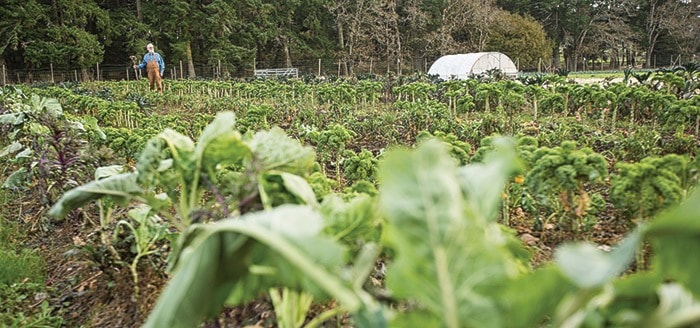Is there a future for agriculture on the West Shore?
The Beecher Bay Scia’new First Nation have been living off the land in Metchosin for thousands of years and European settlers began farming in Metchosin as early as the 1850s.
Farms in Metchosin, Sooke and the West Shore grew an abundance of crops, had cattle, raised chickens, pork and lamb.
In 1950 Vancouver Island was producing close to 90 per cent of food consumed locally. Today, agricultural activity is still present in Metchosin, but there are warning signs that the future of farming in the region could be in peril.
However, with some innovation and community support, the conditions can be fostered to promote local food production and consumption.
The West Shore Chamber of Commerce recently had two studies conducted by Royal Roads University MBA students, who examined the current state of agriculture in Metchosin/the West Shore and the feasibility of increasing agricultural production in the region.
The studies, conducted by RRU MBA students Jeff Townsend and Lisa Makar, were not released (the Gazette spoke to Townsend and Makar for a November story). They showed reasons for concern but hope for the future.
The total number of farms in the West Shore declined marginally in 2011 (from 225 to 217) since 2006. This decline appears to be steady and inexorable and has extended over several censuses.
In addition, the total number of farm operators has also declined in tandem with the drop in the number of farms. The decline in the number of farms and farmers throughout the West Shore is astounding. The average age of farm operators increased from 55.1 years to 57.4 years between 2006 and 2011 and 60 per cent of farm operators are over 55.
These statistics show there is a definite need to assist farmers in developing farm plans to guide their farmland, bringing established and new farmers together to share experiences and ideas, and building a community farmers’ network to provide support and necessary tools to increase food production.
Townsend’s research examined the current state of agriculture on the West Shore with a focus on Metchosin. He found 62 per cent of farms in the region earn less than $10,000 per year. Owners are motivated by lifestyle, not economics. These farms generate less than five per cent of the agriculture revenue in the region.
Presently only eight to 10 per cent of locally consumed food is produced on Vancouver Island and this raises food security alarm bells. The average person spends approximately $8,000 per year on food. This creates a huge market opportunity to produce more locally grown food. In addition, community buying supports alternate business activities that benefit the economy.
Makar’s research examined the feasibility of increasing agricultural production on the West Shore, again with an emphasis on Metchosin. Her findings highlighted some interesting models that could be a road map for increasing food production in the region.
Most of the findings call for different levels of community support:
1. Improved infrastructure. There is a shortage of abattoirs, transporters, storage facilities and wholesalers that cater to local farms.
2. Formation of co-operatives to build infrastructure and market goods to consumers.
3. Development of a strategic regional agricultural plan.
4. Develop business skills for farmers.
5. Seek and develop opportunities for distribution and support by improving connections between farmers, wholesalers, restaurants and local consumers.
Given the fact 62 per cent of farms bring in less than $10,000 in annual revenues, it’s pretty obvious there is plenty of room to grow, no pun intended.
The West Shore has some of the best year-round growing conditions in the country and there is plenty of land that can be used for small-scale intensive farming.
There are also lots of eager consumers searching for local food not too far down the road.
It would be a shame to see all this fantastic farmland go to waste. We should make local food production and consumption a priority; it makes good economic sense. Besides, fresh local food tastes better.
– Craig Sorochan
